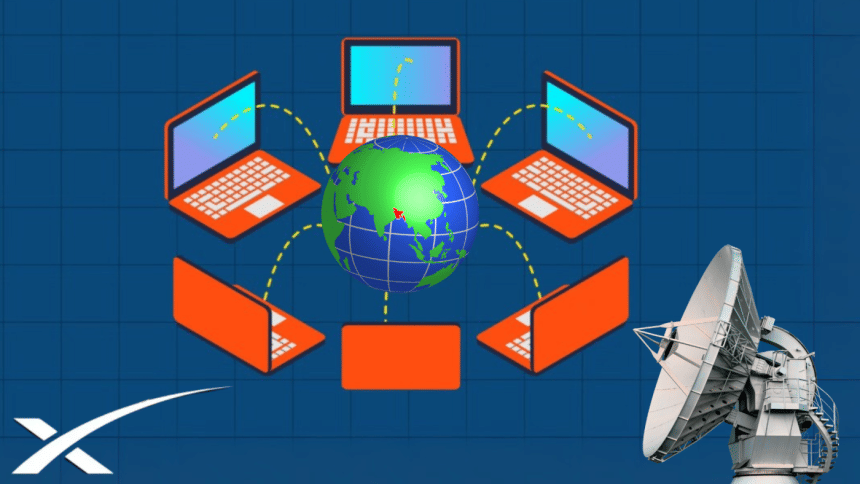Debunking the Starlink paradox in Bangladesh

In May 2025, Starlink deployed its satellite internet services in Bangladesh. This moment was hailed by the interim government, led by Prof Muhammed Yunus, as a major step towards the realisation and promotion of its economic development vision for the country by bridging the digital divide.
An equally important part of the narrative was the promise of an uninterrupted internet connection, given that Bangladesh experienced at least 17 instances of internet shutdowns under the past regime as part of its attempts to silence dissent and provide a cover for violence. The narratives were straightforward and politically convenient for a government seeking legitimacy and under pressure to demonstrate progress.
As the celebratory narrative for Starlink fades, the underlying reality comes into sharper focus, one that raises more questions than it answers. Who will actually benefit from this service? How does the introduction of Starlink sit with concerns about digital sovereignty? To begin answering these questions, we must first challenge some of the prevailing assumptions.
The promise of a digital leapfrog
Starlink's launch is marked by the vision for "digital leapfrogging" that has gained particular traction with the public under the interim government. However, at the heart of the issue is a simple but unavoidable fact: Starlink is prohibitively expensive for those whom the leapfrogging rhetoric claims to serve, particularly rural and low-income urban communities in Bangladesh.
And the financial cost is only a part of the whole story. Equitable access is further undermined by barriers in payment infrastructure. Starlink requires users to access international financial systems when just over 43 percent of Bangladeshis are currently banked. Strict capital controls and limited cross-border transaction mechanisms form yet another exclusionary layer.
This accessibility and affordability gap raises serious questions about whom the satellite internet is really for. While the narrative of "connecting the unconnected" is frequently invoked, the economic barriers suggest that high-speed satellite access can become yet another luxury good in an already unequal digital landscape.
Anti-competition concerns
An important but overlooked consequence of Starlink's deployment and its technological advantage is the impact its entry may have on the market. Local internet service providers (ISPs) may struggle to compete with a well-resourced global provider that may not be subject to strict domestic regulatory frameworks that telecommunication providers are obligated to follow. This development could potentially lead to a concentration of bigger industry actors. For example, Starlink equipment has been set up in 96 percent of municipalities in the Amazon in Brazil, giving it monopoly over the region's internet and information access. Ultimately, such a market shift undermines users' right to access information through affordable and reliable internet services, and highlights the need for regulation to balance innovation with fair competition.
The interim government not only fast-tracked Starlink's licensing application but also actively supported its launch campaign. This blurs the line between public and private interests, raising concerns about the government's ability to hold Starlink accountable. It also sets a troubling precedent: other providers may not receive equal treatment, and the state risks becoming a public relations arm for private technology firms.
Meaningful connectivity is dependent on maintaining a plural and interoperable ecosystem where users have choices in the types of services available to them. It's not just about having internet access, it also means not being reliant on any single company's business model. Instead, adopting and promoting a range of internet services with government investment in the development of local infrastructure can build a more competitive and resilient market and digital ecosystem.
Can Starlink solve internet shutdowns?
Another key narrative is the positioning of Starlink as a form of "resilience," a critical safeguard against potential future internet shutdowns. This framing is of particular importance given the context and history of internet shutdowns in Bangladesh—most recently, the nationwide blackout during the 2024 student-led mass uprising. However, it is important to state that Starlink's ability to provide internet services in the country is still fundamentally tied to government regulations and licensing. Starlink was able to launch its services after receiving a 10-year operating licence from the Bangladesh Telecommunication Regulatory Commission (BTRC). Although the contents of the licence are not public, it reportedly includes strict requirements such as routing internet traffic through local gateways and connecting to government-approved international internet gateways (IIGs). What this means is that by making Starlink route its traffic through local gateways, control remains centralised with the government.
Importantly, in order to operate in Bangladesh, Starlink must also obtain permission to use specific radio frequencies, known as the spectrum. Since governments regulate spectrum, they ultimately retain control over these frequencies and, in turn, the deployment of satellite internet services such as Starlink. In other words, despite the promise of technical resilience, Starlink's deployment remains subject to government intervention, which can restrict or block the permission to use the necessary spectrum.
Additionally, despite being satellite-based, Starlink still depends on physical infrastructure. Currently, Bangladesh is working with several companies on establishing ground stations across the country to support Starlink's deployment. And while progress is underway, developing the necessary supporting infrastructure remains a significant challenge.
What we see is that satellite internet offers the illusion of resilience without any guarantees. It becomes a narrative of progress that lacks the institutional and technical foundations necessary to sustain access and accountability during moments of crisis.
The myth of digital sovereignty
Starlink's arrival in Bangladesh is often hailed as a leap towards "digital sovereignty," but the reality is that it demands a costly trade, exchanging national agency for access. This trade-off doesn't strengthen the country's ability to control its own digital faith; it chips away at its very core, offering only the illusion of autonomy while deepening external dependency.
Relying on a foreign-operated satellite service for critical internet connectivity effectively transfers a portion of Bangladesh's digital backbone to an external private actor, whose commercial and geopolitical interests may at some point diverge from the country's priorities. The 2022 Ukraine example, in which Elon Musk unilaterally decided to restrict Starlink's satellite coverage over Occupied Crimea, highlights the risks of technological dependency that Bangladesh may have to confront in the future, especially amid rising geopolitical tensions and the market concentration of technology companies. If critical decisions about access to internet connectivity—and in this case, about satellites—can be influenced by the personal decisions of an individual, then the myth of sovereignty quickly turns into a liability. Without robust legal safeguards, public oversight, and investment in local infrastructure, Bangladesh may simply be exchanging one form of dependency for another.
What we see is the contradiction between the promises Starlink offers and the reality it delivers—a paradox. The deployment of Starlink in Bangladesh promises universal access to bridge the digital divide, but the reality is that its high costs and reliance on international payment systems make it largely inaccessible and unaffordable to the people it should serve the most. It promises resilience against shutdowns, but the reality is that through licensing, regulation on spectrum, and mandatory routing through local gateways, it remains subject to the type of centralised government control we have witnessed in the past. Finally, with the deployment of Starlink comes the promise of digital sovereignty, but when the reality comes into sharper focus, we see that we risk outsourcing critical infrastructure to a foreign private company and creating dependencies. If the interim government wants to leverage Starlink, it must develop specific economic, legal and regulatory solutions that actively navigate the complex trade-offs this technology entails in the context of Bangladesh.
Dinah van der Geest is senior programme officer at ARTICLE 19's Global Team Digital working at the intersection of technology and human rights, advocating for rights-respecting policies and standards.
Sabhanaz Rashid Diya is executive director at Tech Global Institute where her work focuses on rights-respecting policies and legislations on privacy and data protection, and artificial intelligence.
Views expressed in this article are the authors' own.
Follow The Daily Star Opinion on Facebook for the latest opinions, commentaries and analyses by experts and professionals. To contribute your article or letter to The Daily Star Opinion, see our guidelines for submission.


 For all latest news, follow The Daily Star's Google News channel.
For all latest news, follow The Daily Star's Google News channel. 









Comments